One of the main driving forces of all businesses that have an online presence are sales funnels. It’s one of those marketing terms that seem alien if you never looked into it, but I promise you’ve been exposed to many versions of this eCommerce strategy.
Proper sales funnels are automated and can increase your revenue by up to 30%. But today, I want to cover the basics of sales funnels and how you can start using them to increase revenue for your business.
I'm not just showing you the traditional type of sales funnel that people usually think of, a follow up sequence that pushes one time offers for increased order value. While that is still valuable, it’s just a small sample of what a full sales funnel can do for you.
This article is going to really hit on every type of sales funnel that we use in our eCommerce businesses. That way, you can copy our eCommerce strategy and build a few core sales funnels for your business. We're going to cover the basics of four different types of sales funnels so you have a solid understanding of your next steps.
The first type of funnel we're going to talk about is what's known as a product funnel. From there, we are going to talk about content sales funnels. Next we’ll cover advertising sales funnels, and then finally we are going to talk about email sales funnels.
What Are Sales Funnels?
Before we get into specific sales funnels, I wanted to cover what they are from a practical standpoint.
Most sales funnels are made of a few different parts...
- First is an ad that they see on Facebook, Google, or some other social platform.
- Once they click that advertisement, you’ll often be asked for information to get an instant discount.
- You will capture their email and send them content, promotions, and other information you feel will connect your customer with your brand.
- They’ll also be retargeted on every social platform from Instagram to YouTube.
This multi-touch point approach is a standard eCommerce strategy for modern marketing and is designed to endear the customer to your brand. That way they’ll buy, and continue to buy from you.
One of the most interesting things about being in business is you begin to notice when you’re in a funnel and naturally analyze the experience.
After you finish this article and have a strong grasp on what a sales funnels is, I encourage you to take a look at your inbox and find these funnels. Then you can utilize the strategies used by some of your favorite companies to make more revenue with your business.
1. Product Sales Funnels
We’ll start with product funnels. This is one of the most traditional sales funnels. It’s designed to sell a product.
For this article, even though this works on anything, I will assume you're selling physical products, and you're selling them on Shopify. In this example, we’ll be using a service called ClickFunnels, because it was designed for build each step of a sales funnel.
You’ll have your website setup and your products listed for sale. Visitors will either buy a bundle of items, or they're going to be buying one thing at a time. But what happens next?
The typical interaction with an eCommerce store using the strategies I lay out in Drop Ship Lifestyle goes like this…
- First, customers will come to your website from a Google paid list ad (PLA) having intent to buy.
- They’ll place an order for your product and hit a confirmation page.
- This page gives them all their order information and thanks them for their order, it also promises a email with more details.
That's a traditional sale funnel, it's ‘one step’... go to the website, buy, get your confirmation.
Most traditional types of sales funnels take place either while someone is adding items to their cart, or after they purchase something from your store. Depending on if you're using Shopify or ClickFunnels, this will work a little bit differently.
You can achieve the same things with either platform, but if you're on Shopify and you want to do post purchase upsells, you will need different apps that will make this all possible. But again, it is all possible, so you can do this regardless of what platform you're on.
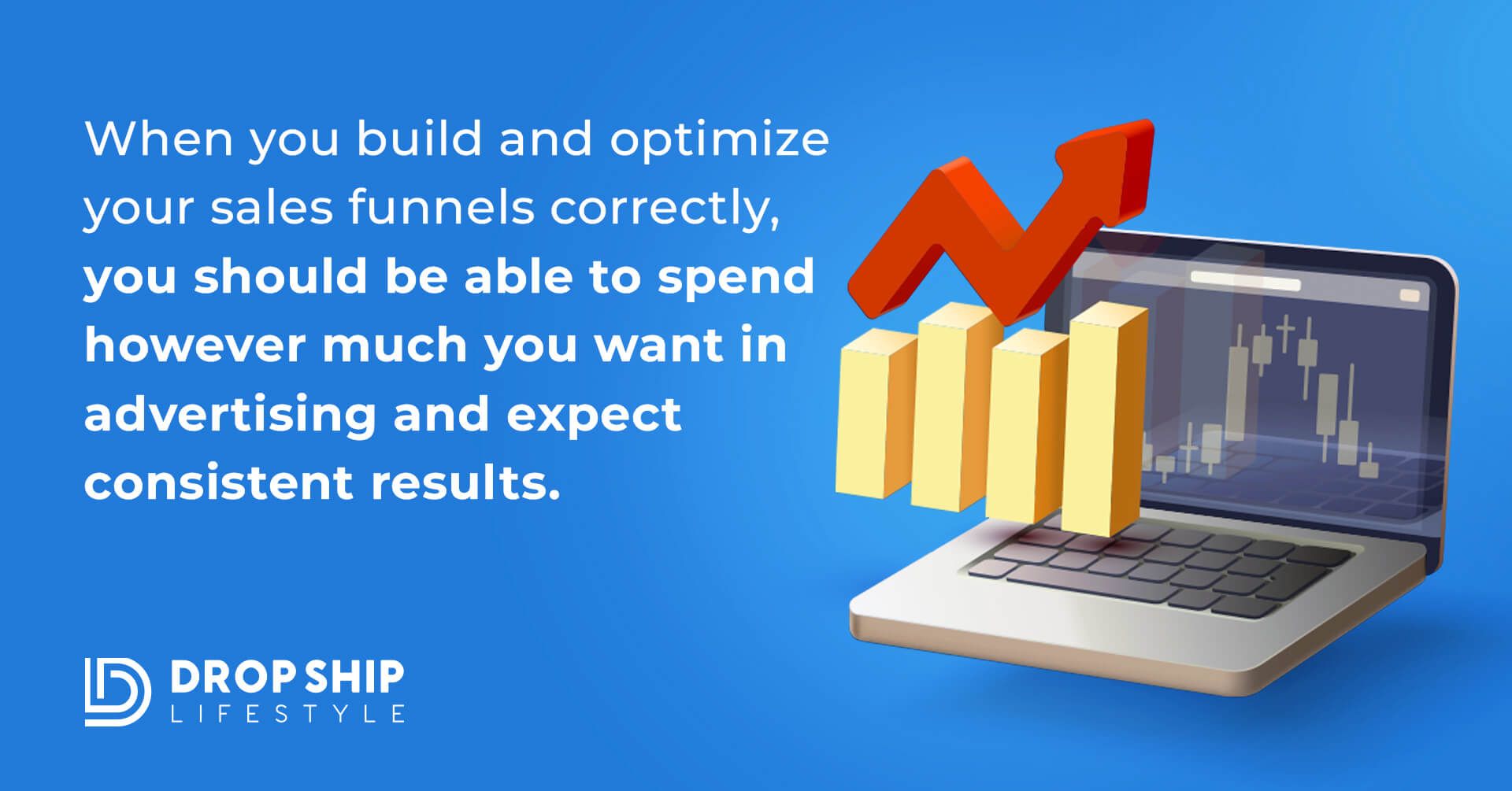
The whole purpose of all these funnels is to generate more revenue than you spend on advertising. This is the key to scaling your business, because you can always control how much you spend.
When you build and optimize your sales funnels correctly, you should be able to spend however much you want and expect consistent results.
Let's say right now your advertising gives your three dollars in revenue for every dollar you spend. With an optimized sales funnel... you’ll drive that return up to five, seven, or even twenty dollars for every dollar spent.
Just know that there is a limit. Once you spend a certain amount on ad spend, you’ll likely hit a plateau on your returns. This depend largely on the size of your target audience.
An eCommerce Strategy For Maximizing Profits
A lot of people focus on that first sale, and see it as a one-time event. But the best businesses see this first transaction as the beginning of a long relationship.
Maximizing profits is about turning that first sale into many more sales while increasing their average order value AOV.
In the most basic product funnel, they visit to your website, they buy your product, and they went to the confirmation page. At that point, that's how much money you made on that one customer.
So their average order value is what that product was priced at. Now with a product funnel, you offer them a product right after they've bought the initial product. This is what's typically referred to as a ‘one time offer’ (OTO).
This is a standard eCommerce strategy, and one that will increase your revenue without much more effort on your part.
Increase Average Order Values With One Time Offers
Typically you'll offer this person who just purchased a complimentary product at a discounted price, and the discount is one time only. This works best when it comes after they've completed their order, because they've just spent money with you. They are already in the buying mindset.
Let's just use the example I always default to, where someone bought a stand-up paddle board from you.
- You sell stand up paddle boards
- Someone goes to your website
- They buy a stand up paddle board from you
- You get around $700 for that product
Right after they confirm their order, instead of seeing this confirmation page right away, they see a one time offer for a brand-new paddle that they can use with their paddle board.
This paddle normally sells for $200 but if they take it right now, they're going to save $100. But only for the next twenty minutes, because this is a one time offer for buying the paddle board.
That is how products funnels work.
The thing is, a lot of people don’t even do this with their online stores. And just by adding this one step of offering a complimentary product at a discount, you would increase your average order value drastically.
But it goes further than this. Let's just go back to this example... You just sold them a paddleboard, they bought the paddle board, then they see the one time offer.
“Hey, do you want this paddle for fifty percent off?”
Whether they take your first OTO, you could still offer them other things.
If they buy it may be this page, the second OTO page.
The second one-time offer says something like, “Hey thank you so much for your order, that's awesome that you added the paddle. Now do you want to add a carrying bag right? Or how about adding tow kit to carry it around?”
Here are the steps laid out…
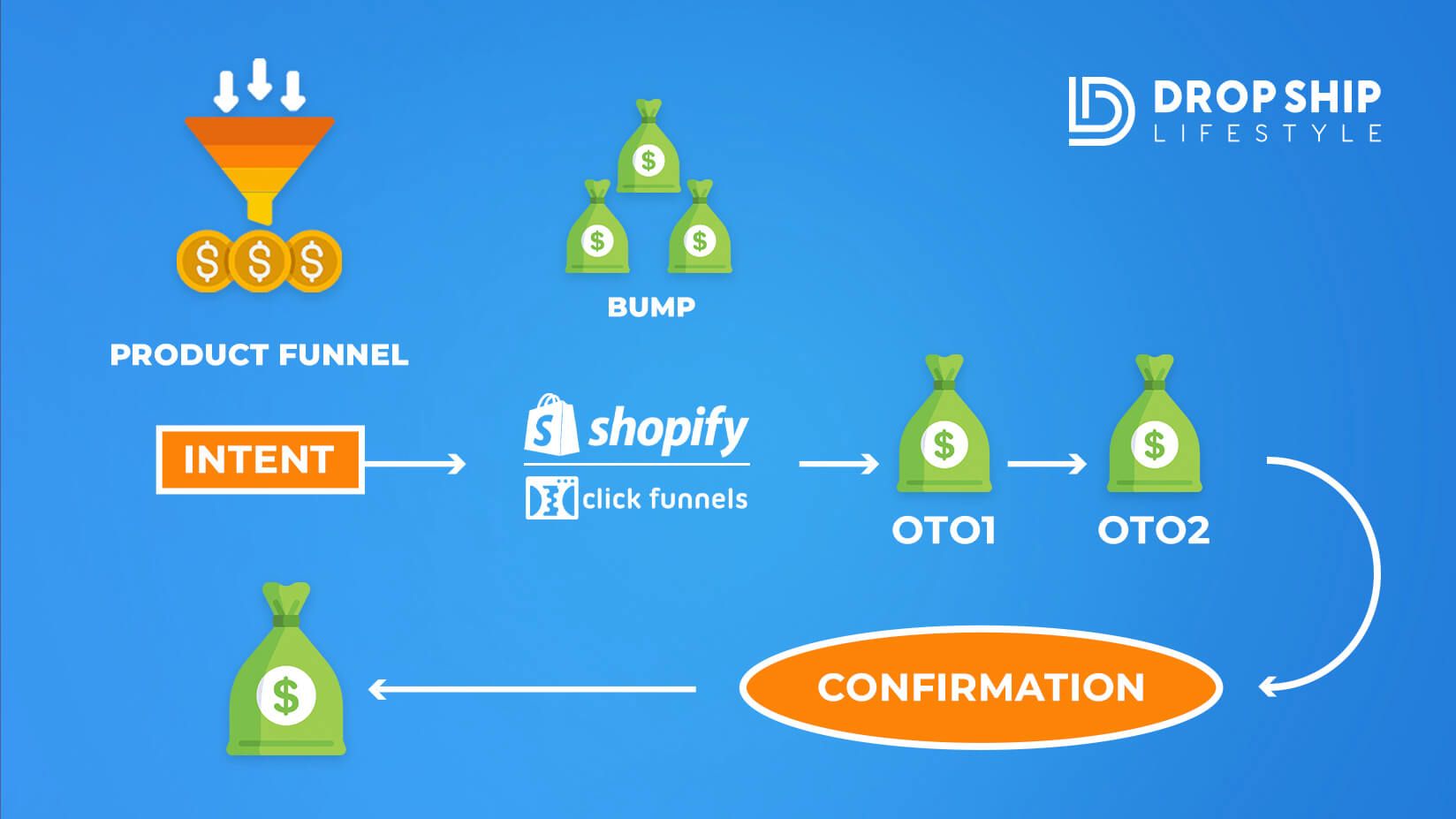
If they don't buy the paddle the first time, you can make another pass. Hoping that they follow along the ‘In for a penny, in for a pound’ mentality.
Or you can make another pass offering them a different product. These products sales funnels can go for as long as you want them to.
If you wanted to have a hundred different one time offers, you could. Your customers will probably be angry because they're not expecting to be sold to over and over.
But if you set it up in a way where the product really makes sense to the person that just bought from you... they're not going to be upset about receiving more OTOs. They're going to be happy about it and happy to give you more money.
You can also build this into your actual product pages with Shopify or ClickFunnels. If you're in ClickFunnels, this would be literally called an order bump element in that platform.
On Shopify, you can use different apps that allow pretty much the same thing.
With either program, you can show complimentary products to your customer before they enter their credit card.
2. Content Sales Funnels
The second type sales funnels are content funnels. Their purpose is to attract people to your website while building brand loyalty and giving them upfront value. That way they grow to know, like, and trust your business - which is the cornerstone to customer loyalty.
The first step of our funnel is typically what I would refer to as the PLA's or paid list advertisements. Customers find these advertisements when they search Google. They see your PLA ad on Google and click, leading them to your Shopify store.
What's good about this is it's showing your advertisement to people with intent. These people are searching for specific product names, brand names, or stock keep unit (SKU) numbers.
One key eCommerce strategy is to only advertise to people with intent, it lowers ad coast and gives you a higher return on ad spend.
But what if we want to get in front of more people?
What if we want to advertise to people that don't know anything about you yet?
People that don’t know you’re selling paddle boards, or even know which paddle boards they want. They don’t even know if they want a paddle board yet.
The best way to achieve this goal is to build out a step that comes before our paid acquisition through PLAs.
You do this by creating content that people may be interested in... people who will eventually want a paddleboard.
Maybe we're doing things like paddle board reviews on YouTube. Then we're posting them to Facebook.
Maybe we're building an Instagram page that shows different people paddle boarding in famous places. Or we show people doing yoga on paddle boards.
It can be any content that helps your customers imagine how much better their life would be if they bought your product.
Founder and CEO of Prep Expert, Shaan Patel, uses webinars to turn his leads into loyal customers. Here’s what he had to say about his experience with content sales funnels:
"At Prep Expert, we've found that besides standard marketing fare like email blasts, blog posts, social media ads, etc., our most consistent traffic and sale driver is our weekly webinar funnel. Three times a week, I broadcast a free class sharing 10 tips students can use immediately to start preparing for their SAT/ACT, win scholarships, and improve their dream school admission chances.
At the bottom of our funnel, the webinar itself acts as the perfect bait for traffic to filter through our targeted Facebook ads, retargeting, email blasts, and Adwords efforts. The end result? Consistent sales revenue via the webinar's exclusive coupon code, and week to week traffic measurement - both signups and attendees. We use this data to gauge overall user engagement and revenue patterns throughout the year."
If they don't buy the paddle the first time, you can make another pass. Hoping that they follow along the ‘In for a penny, in for a pound’ mentality.
Or you can make another pass offering them a different product. These products sales funnels can go for as long as you want them to.
If you wanted to have a hundred different one time offers, you could. Your customers will probably be angry because they're not expecting to be sold to over and over.
But if you set it up in a way where the product really makes sense to the person that just bought from you... they're not going to be upset about receiving more OTOs. They're going to be happy about it and happy to give you more money.
You can also build this into your actual product pages with Shopify or ClickFunnels. If you're in ClickFunnels, this would be literally called an order bump element in that platform.
On Shopify, you can use different apps that allow pretty much the same thing.
With either program, you can show complimentary products to your customer before they enter their credit card.
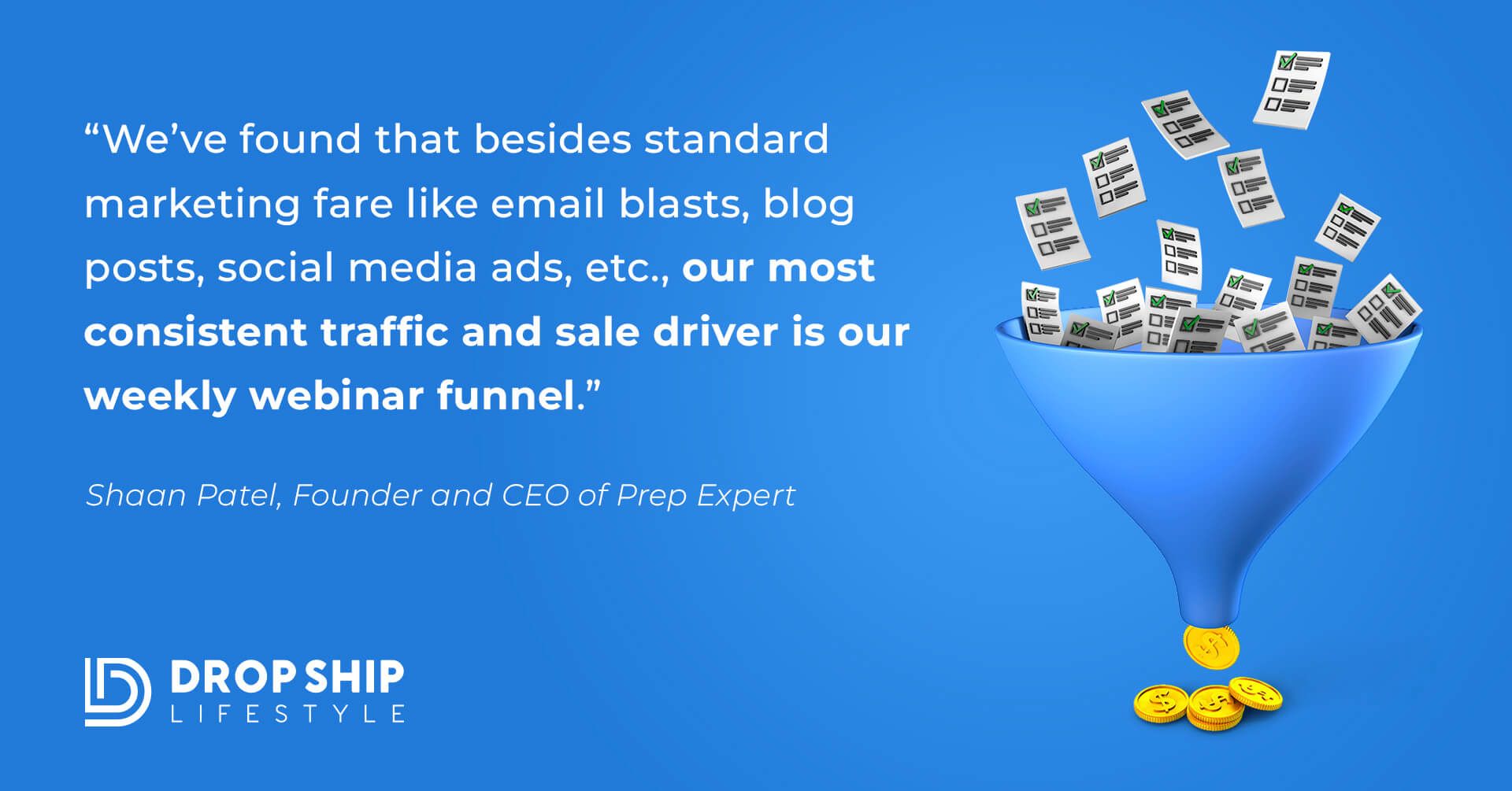
This content won’t immediately attract buyers, but we're going to put out content that our customers would watch.
Some common types of content include blogs, podcasts, videos, PDFs, webinars and eBooks.
For instance, you could do a paddle board podcast and people that would be interested in paddle boarding would listen. Then we could talk directly to them. Once we’ve attracted customers our content funnel, then we’re able to target people that engaged with that content.
An important note here is that just because they engage with our content, doesn’t mean they’re ready to take their credit card out and buy from us. But it does mean that they're at least interested in the type of stuff that we sell.
Over at Simply Smart Living, they’ve always believed in content first and have built their business with content marketing:
“SimplySmartLiving.com was built with a strong content component from day one (and that was in 2001, long before content was king). Our family-friendly home products focus gives up plenty of opportunities to create related content, such as product safety information, childproofing guides, DIY projects, decor tips and tricks, reviews, and related videos. This creates natural awareness, interest, and action funnels with a wide variety of targeted search entry points.
As social media rolled out, we added Facebook and Pinterest posts to the entry-point mix, plus occasionally use Facebook posts to drive traffic to specific high-converting pages.
Most recently, we're finding that our product review roundup-type content acts as a one-page search or social-entry click funnel. On these pages, we create awareness, educate, and make actionable recommendations, all in a concise, high-converting capsule.” -Krista Fabregas, eCommerce Analyst.
Once we attract a huge list of people that are engaging with all of our content, we can show them ads because they've shown a little intent.
They don’t have as much intent as people that click PLAs, but we can retarget them with Google Adwords, YouTube ads, and on Facebook.
When we're retargeting them, we're not just showing them the content. We're showing them actual promotions for our paddleboard store. We're getting them back to our Shopify store or to our Clickfunnels pages.
We attract people with broad content early on and we ascend them through the sales funnel as their interest grows. Once they engage with that, we show them an ad for a relevant product.
With this business strategy, it’s much cheaper to target people since they’ve already engaged with your content, rather than targeting people that haven’t interacted with your brand.
3. Advertising Sales Funnels
The third funnel is our advertising funnel. Advertising funnels start with promoting content. But there is more to it than the content funnel.
Here is a quick breakdown:
Step 1: Putting out relevant content.
Step 2: Retargeting most people on all the major channels. Those are the people that engage with your content right.
Step 3: Retargeting people that visit your site and don't buy. We’ll follow them around the Internet with ads specific to where they are in the buying funnel. Then they finally take action.
Step 4: After they buy and they're on your confirmation page, we want to know a few things.
- What they bought
- If they took our upsells.
- If they’re interested in any other products that we have to offer
With this information we can strategically advertise other products to them. At the very least, we can let them know when we have new products.
We're trying to get them to buy complementary products after they buy initially. That way you make the most out of all the effort spent on attracting this customer, increasing the overall lifetime value of your customers.
4. Email Sales Funnels
[bctt tweet="The focus of email marketing is to move people to different stages of their discovery process with your brand. Each stage should strengthen your relationship with your customers." username="ecomlifestyle"]
The last is heavily neglected by a lot of businesses. This also the main eCommerce strategy for maximizing lifetime value and getting the highest return on your ad spend.
Eng Tan, CEO of Simplr explains why using email sales funnels is a crucial eCommerce strategy for building strong relationship with your customers:
“...a consumer needs multiple touch points during the cycle to finally consider a purchase. The "top-of-the-funnel" for an eCommerce business typically consists of paid traffic (ads) and organic traffic. Organic traffic can be tricky to nail down but can be accelerated through quality content generation, on-page search optimization and link-earning. Once a potential customer has landed on a site, clear and informative product descriptions that speak directly to the target audience as well as quality visual assets are key to generating a purchase. For customers that don't convert on the first try, find a way to keep your brand and product with them using tactics like retargeted social ads and email marketing campaigns.”
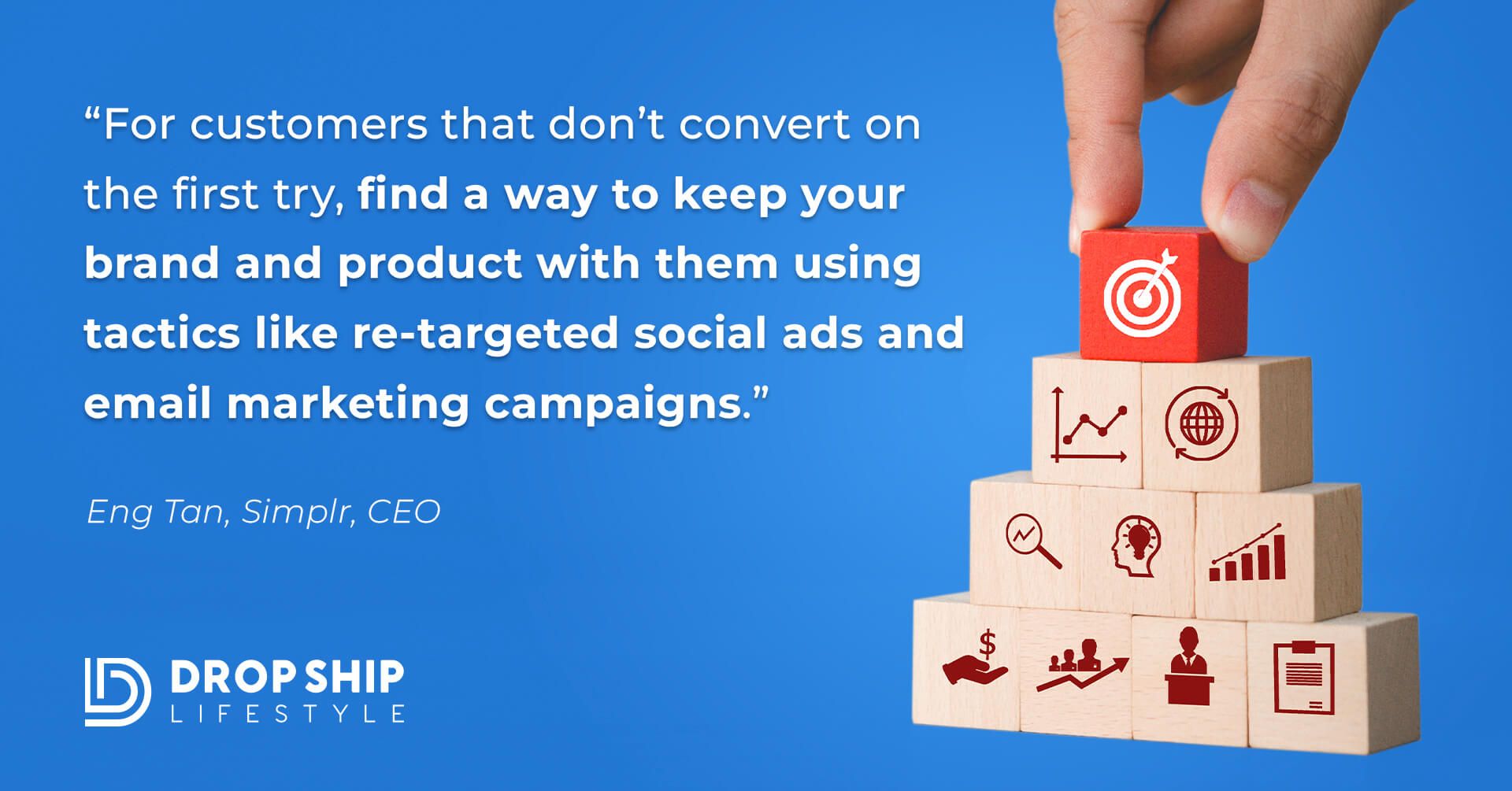
Our email funnels are based on actions that take place on our website, so when people come to your website, a few things might happen.
One of them is that they might enter a giveaway on our website where we either give away products or discount codes.
We put out a lot of what I would call "bait", and people join our email list for these promotions.
We deliver on our promise, but then we also follow up with an email funnel that sends them back to our store to get them to purchase one of our items.
Another example of an email sales funnel is if they abandon their checkout.
If they abandon the cart we’ll send emails that focus on getting them back to the items that they looked at. We're guiding them through a series of emails back to their cart to complete their order.
Then there are follow up emails for when someone does purchase. We don't just try to get them to take the OTO’s again, or other products. We also promote affiliate offers and information products.
Those are just a few examples of effective sales funnels, and some of the ones that I use in my businesses. You can discover more about building sales funnels, including copy/paste templates for instant setup, in my Inbox Funnels course.
Do you use sales funnels in your business? Let me know in the comments below. Also, if you know someone who would love this article you can share it with them here…

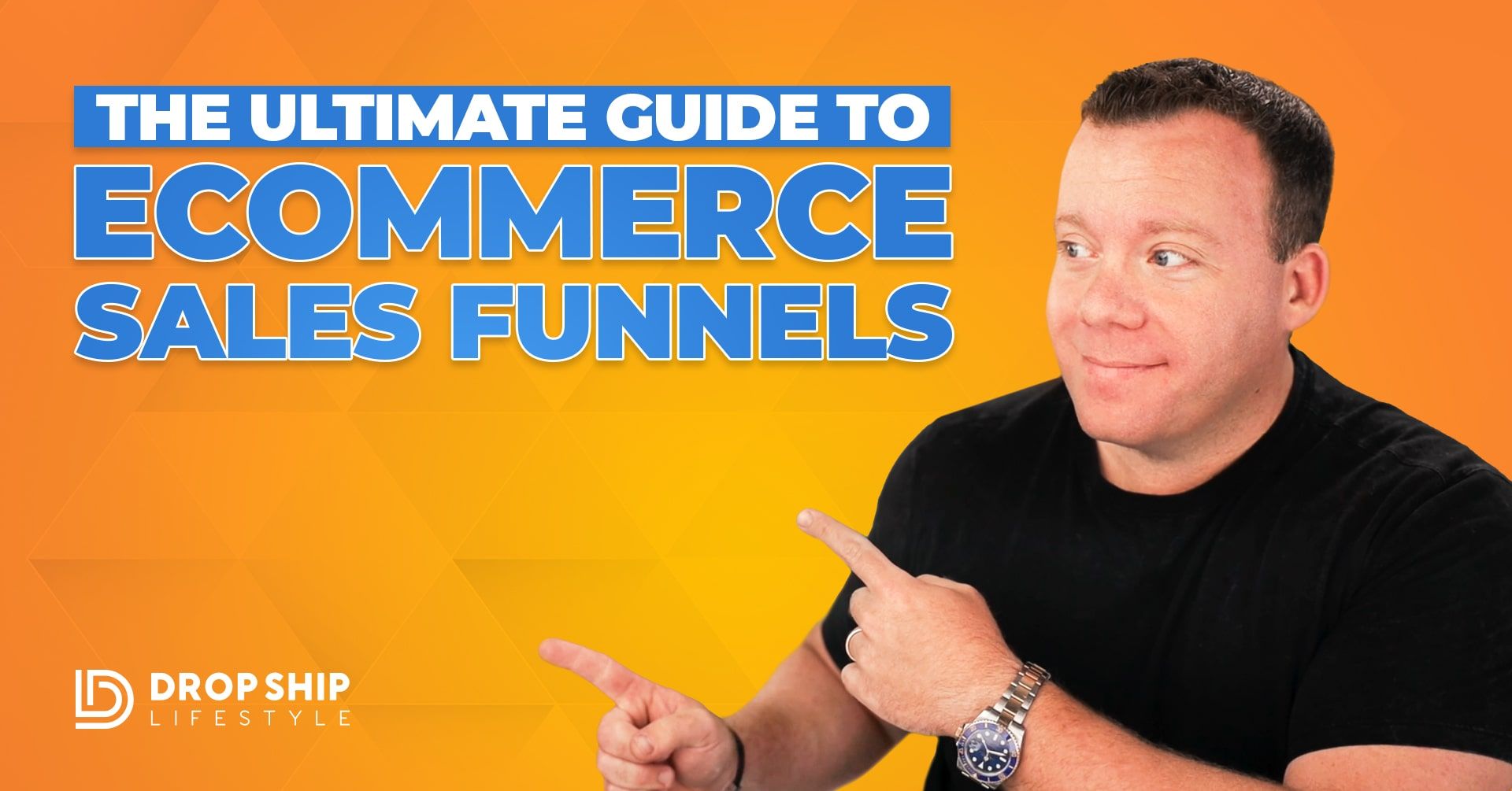

Hey could you give me the copy paste template i can use for the sales funnel
Hi, If you’re a member of Drop Ship Lifestyle you can access all of our page templates in Module 5. If you’re not a member yet you can enroll here: Get Drop Ship Lifestyle.
Sounds great
I want to know more
Hi Rebecca,
You should register for the live webinar that I’m hosting this Thursday evening at 8 PM EST!
It will be a great intro to high ticket drop shipping and I’ll also be doing a live 30 minute Q & A session at the end 🙂
Here’s the link to register:
Drop Ship Lifestyle Webinar
Hope to see you there!
Anton
Hey Everyone,
As many of you already know I created Drop Ship Lifestyle after selling a network of eCommerce stores and then trying to find a community of other store owners to network with… What I found was a bunch of scammers who promised newbies they would get rich quick by following their push-button systems!
This led me to create a new community along with online training that shares how to build a REAL online business.
I’d love to hear what you think… it’s a 2.5 hour dropshipping webinar designed to help you drop ship profitably… all for free.
Be sure to click here to check it out and send me your feedback!
If you go through the How To Drop Ship Profitably webinar and still have questions just contact me and I will help you out.
– Anton
Hello, I have a comment on our statement “Retargeting people that visit your site and don’t buy. We’ll follow them around the Internet with ads specific to where they are in the buying funnel. Then they finally take action.. “. This actually happened to me when I went to a swimsuit site and took an interest in a particular suit. I even went so far as to bookmark the site.That add literally followed me EVERYWHERE I went on the net when I used Chrome as my browser. Guess what happened. I got so irritated with my little shadow I deleted the site and almost sent a nasty note because I really did not appreciate what I viewed as harassment. So I wonder how effective that tactic really is since I don’t think I need to hound my potential customers to spend money with me. Just a thought.
Thanks for stopping by and leaving a comment, Tina!
I’m curious if there was anything specific about the ads you were seeing from the swimsuit company that were a turn off for you?
The reason I ask is that we have consistently found our remarketing ads to generate our highest ROAS (Return On Ad Spend).
With that being said, we try to do a few things to not annoy our people. For example:
1) We are not pushy with the wording in our ads / videos.
2) We monitor the frequency of our ads so that the same people do not keep seeing the same ad over and over again.
3) We have a short time frame for remarketing, so we’re not following the same people around with the same ads forever.
If brands don’t do these things I certainly see how they could damage their brand reputation.
I would love to hear about the specifics of the swimsuit ads that you felt to be harassing.
Thanks!
Anton